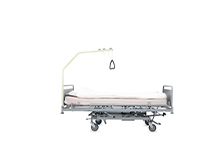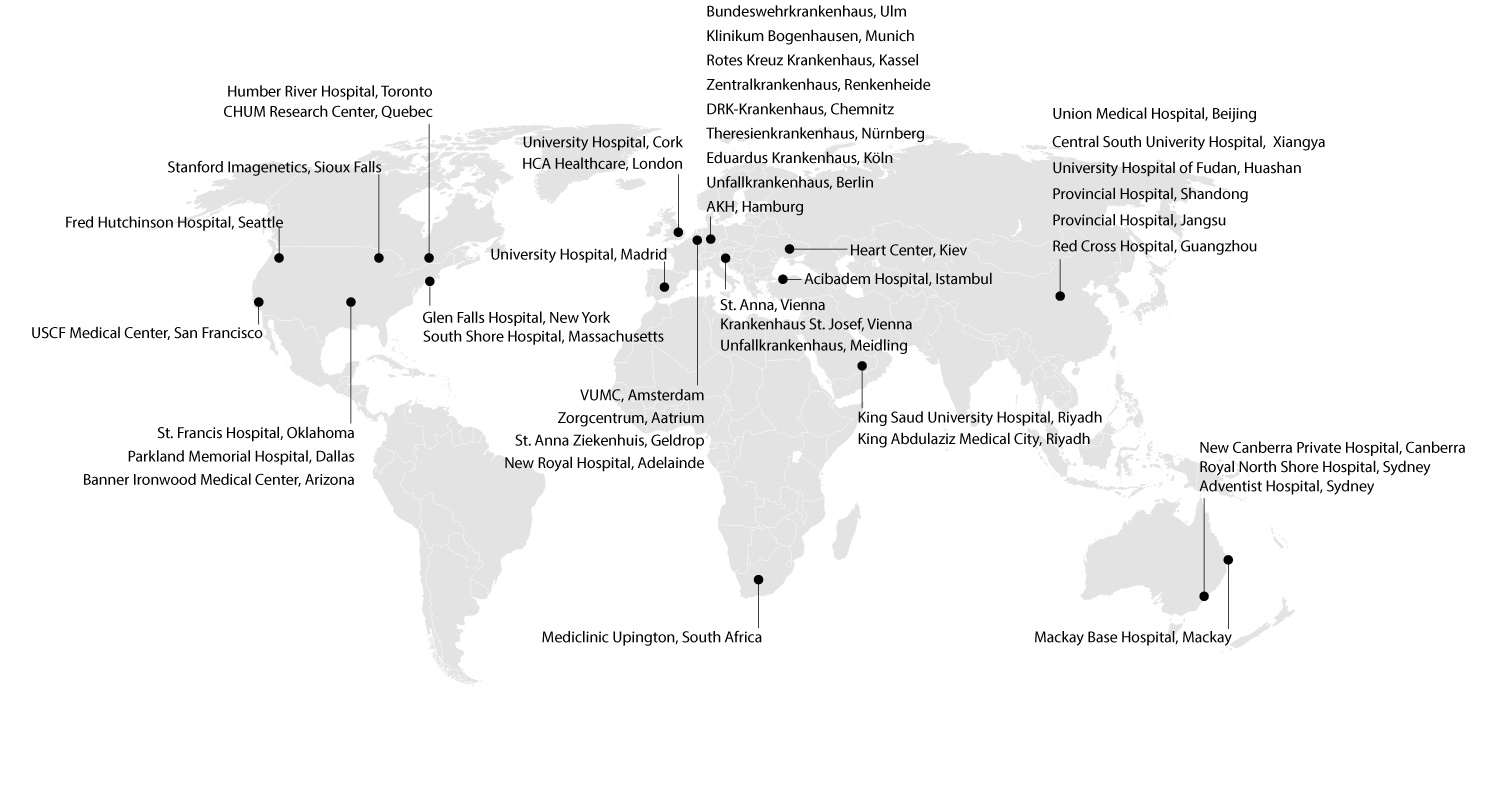Humidification in hospitals
In hospitals and operating rooms, the right air humidity ensures better wellbeing of patients and staff, protects against electrostatic charges, and curbs the spread of germs and bacteria.
Humidity has a major impact on people’s health and wellbeing. Classic effects of overly high or low humidity include: fatigue, poor concentration, headache, stinging eyes, and irritation of the respiratory tract.
Humidity is crucially important to the functioning of the immune defenses in the nasal mucous membranes, as the dryer the nasal mucous membrane, the more susceptible the body is to bacteria, viruses, and pathogenic germs. Furthermore, correct air humidity levels are also crucial to the equipment used in operating rooms. Electric equipment usually responds extremely sensitively to static charges that inevitably build up when the air is too dry.
Spread of germs in dry air
Spreading of germs at optimal humidity
Why does air humidity reduce the risk of infection?
In dry air, the germ droplets also dry out. They lose weight quickly, become lighter and float through the room for a long time. At an air humidity of 40 to 60%, however, the germ droplets remain large, heavy and sluggish. They sink quickly to the ground, reducing their distribution in the room air.
Incapacitation or preservation
The relationship between indoor humidity and microbes by Dr. Walter Hugentobler
Many hygienists, epidemiologists and construction experts still assume that the lowest possible humidity prevents the growth and propagation of bacteria and fungi and contributes to the prevention of diseases.
This view is not correct. Dr. Walter Hugentobler gives an insight into how indoor humidity in buildings affects microbes.
read more
The basic misunderstanding is that “humidity” and “material humidity” are intuitively linked in many people’s minds and wrongly perceived as synonymous. Neither fungi nor bacteria can cover their water requirements from the humidity. They depend on liquid water on non-porous surfaces (condensation water), in porous materials such as gypsum, wallpaper and wood as well as in wet areas (drinking water and sewage systems).
Therefore, the most efficient and healthy way to minimize the water supply to the microbes is not to reduce the indoor humidity, but to improve the insulation of the building shell. As long as the surface temperature does not fall below the critical value (corresponding to 80% equilibrium humidity), no microbial growth can occur. Nevertheless, unsuccessful attempts have been made to prevent the formation of mold through deep indoor humidity for decades. The victims here are the building users, or more specifically, their respiratory tract.
The mucous membranes of the respiratory tract, the eyes and the skin compete with the air for the small amount of water that is still present at low humidity. Since the respiratory tract must condition the dry breathing air to 100% moisture on its way into the alveoli, they dry out. People become susceptible to infections, and the microbes benefit from the ideal conditions for air transmission, as explained below.
Air transfer of microbes
It has been scientifically proven for over 50 years that the air transfer of microbes is promoted by low humidity (and low room temperatures). It has been proven that pathogens for respiratory tract infections (bacteria, flu and cold viruses), but also pathogens of winter diarrhea (rota and noroviruses) as well as fungal spores and fungal fragments can enter the respiratory tract more easily and in larger numbers in dry air. Therefore, reducing humidity to protect against moisture has the side effect of increasing the risk of exposure, not only to mold fungi.
Most microbes know various transmission pathways and preferably choose the one for which the conditions are most favorable at the respective point in time. In heated indoor air, this route is often through the air. Aerogenic transmission via microscopically small droplets, called aerosols, is highly efficient and transport routes are difficult to track. The agent and target of contamination do not have to be temporally or physically closely connected.
A microbe can remain inactive on a surface for days before it reaches its infection target, the humid respiratory tract, via room convection, for example. Research results from several clinical studies with various groups of people show the preventive effectiveness of air humidification during the heating season: Respiratory infections were reduced by 20% in adults and by 50% in children. The number of sick days in the winter fell by 20%.
Physical-biological background
The survival time of airborne flu viruses and other microbes depends on the humidity. While they survive for hours in very high humidity, at a humidity between 40 and 60% they are inactivated within minutes. If the humidity drops below 40%, the viruses and microbes also survive for hours, presumably even considerably longer. They are literally preserved in the dried out droplets. Aerosol physics provides the physical-biological background of this observation: The release of water until the thermodynamic equilibrium state is reached leads to multiple supersaturation of the dissolved and suspended substances at around 50% relative humidity.
This supersaturated solution in the aerosol droplets deactivates the microbes within a few minutes. If the indoor humidity is below a limit value of 40 to 45%, the substances dry out and crystallize within seconds.
The microbes are trapped in the dried aerosols without being deactivated. The cell membranes remain intact and the microbes maintain their ability to cause infection. After renewed hydrogenation, for example after inhalation into a humid respiratory tract, the microbes are released again and can trigger a new infection.
Therefore, the most efficient and healthy way to minimize the water supply to the microbes is not to reduce the indoor humidity, but to improve the insulation of the building shell. As long as the surface temperature does not fall below the critical value (corresponding to 80% equilibrium humidity), no microbial growth can occur. Nevertheless, unsuccessful attempts have been made to prevent the formation of mold through deep indoor humidity for decades. The victims here are the building users, or more specifically, their respiratory tract.
The mucous membranes of the respiratory tract, the eyes and the skin compete with the air for the small amount of water that is still present at low humidity. Since the respiratory tract must condition the dry breathing air to 100% moisture on its way into the alveoli, they dry out. People become susceptible to infections, and the microbes benefit from the ideal conditions for air transmission, as explained below.
Air transfer of microbes
It has been scientifically proven for over 50 years that the air transfer of microbes is promoted by low humidity (and low room temperatures). It has been proven that pathogens for respiratory tract infections (bacteria, flu and cold viruses), but also pathogens of winter diarrhea (rota and noroviruses) as well as fungal spores and fungal fragments can enter the respiratory tract more easily and in larger numbers in dry air. Therefore, reducing humidity to protect against moisture has the side effect of increasing the risk of exposure, not only to mold fungi.
Most microbes know various transmission pathways and preferably choose the one for which the conditions are most favorable at the respective point in time. In heated indoor air, this route is often through the air. Aerogenic transmission via microscopically small droplets, called aerosols, is highly efficient and transport routes are difficult to track. The agent and target of contamination do not have to be temporally or physically closely connected.
A microbe can remain inactive on a surface for days before it reaches its infection target, the humid respiratory tract, via room convection, for example. Research results from several clinical studies with various groups of people show the preventive effectiveness of air humidification during the heating season: Respiratory infections were reduced by 20% in adults and by 50% in children. The number of sick days in the winter fell by 20%.
Physical-biological background
The survival time of airborne flu viruses and other microbes depends on the humidity. While they survive for hours in very high humidity, at a humidity between 40 and 60% they are inactivated within minutes. If the humidity drops below 40%, the viruses and microbes also survive for hours, presumably even considerably longer. They are literally preserved in the dried out droplets. Aerosol physics provides the physical-biological background of this observation: The release of water until the thermodynamic equilibrium state is reached leads to multiple supersaturation of the dissolved and suspended substances at around 50% relative humidity.
This supersaturated solution in the aerosol droplets deactivates the microbes within a few minutes. If the indoor humidity is below a limit value of 40 to 45%, the substances dry out and crystallize within seconds.
The microbes are trapped in the dried aerosols without being deactivated. The cell membranes remain intact and the microbes maintain their ability to cause infection. After renewed hydrogenation, for example after inhalation into a humid respiratory tract, the microbes are released again and can trigger a new infection.

Operating room


ENT patient care


Infants / nursery


Patient room

Condair quality
Our customized systems offer professional solutions for air humidification and dehumidification for the size and conditions of each individual room.
Because professional planning is the basis for functional quality and energy efficiency, we are happy to assist you right from the planning phase.

Hammam, Caldarium and Rhassoul
A hamam is a steam bath in which a special bathing ceremony is held,
and is an important part of Islamic bathing and physical culture.
The focus is...

Steam bath and steam shower
Nowadays, many hotels and health clubs offer spa facilities for the well-being of their guests and members:
A swimming pool, a sauna and more and mor...

Office Rooms
Employees must feel comfortable as they work. Motivation, efficiency, and health can be improved through contemporary design of the workplace. The ri...

Fashion Industry
An “electric shock” when touching a clothes rail; hair that takes on a life of its own when trying on clothes. Dry air can really spoil the fun of go...

Food Storage
Hygroscopic (moisture-drawing) foods interact with ambient humidity. They either absorb water vapor from their environment or give off water vapor.
T...

Data Center
In data centers, humidifiers primarily ensure that electrostatic discharges and damage to sensitive hardware are prevented.

Electronic Industry
The dryer the air, the quicker electrostatic charges occur and the stronger they are. Consistent protection against ESD (electrostatic discharge) has...

Automotive Industry
To achieve optimum results, paintwork must be applied to vehicles in optimum environmental conditions. Crucially, humidity and temperature must meet ...

Call Centers
A good room air humidity in a call center not only ensures the employees’ well-being, but also their performance and health. Today, respiratory illne...

Museums
Museums are charged with the task of preserving treasures of humanity and art. The innumerable, often unique and irreplaceable exhibits are worth man...



